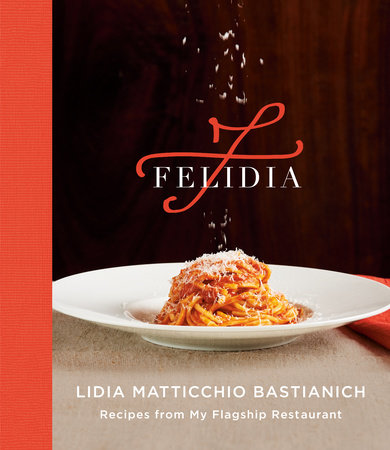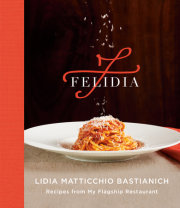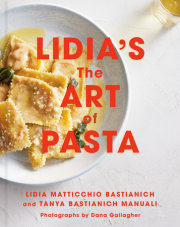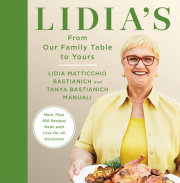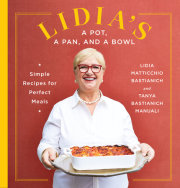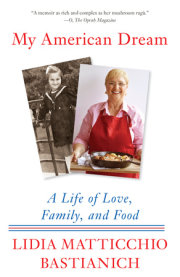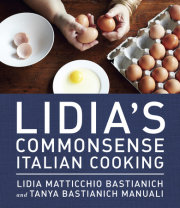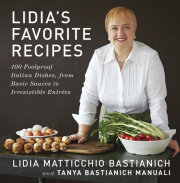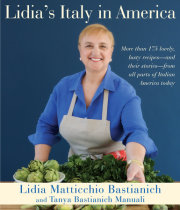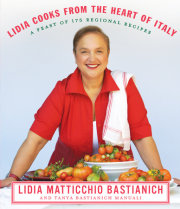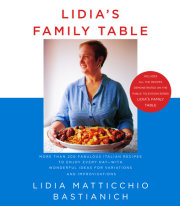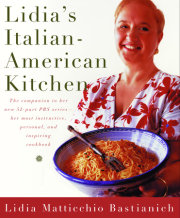BASIL MARTINI Martinis ruled in the 1980s, when Felidia opened, and remain popular at the bar today. The basil martini is a welcome variation in the summer months, when this herb, which both Chef Nicotra and I love, is in season. We both like fresh herbs in our food, so why not in our martinis? The recipe for the syrup makes about 1 cup, more than you need for one drink, but this recipe is easily multiplied for a group. The syrup also keeps for several days in the refrigerator and is good stirred into iced tea or as a base for sorbet. MAKES 1 DRINK
1 cup sugar
2 cups loosely packed fresh basil leaves
2 ounces gin
Micro-basil, for garnish
Basil seeds, for garnish, if desired
Strip of lime peel, removed with a vegetable peeler, for garnish
Combine the sugar with 1 cup water in a small saucepan. Bring to a simmer to dissolve the sugar. Set aside, and let cool completely.
Bring a medium saucepan of water to a boil. Plunge the basil into the boiling water, and cook until wilted and bright green, about 10 to 15 seconds. Transfer immediately to an ice bath to cool. Drain, and pat dry.
Combine the simple syrup and blanched basil in a blender, and blend until smooth. Strain through a fine-mesh strainer. Chill until cold, at least 1 hour.
Chill a martini glass. Fill a cocktail shaker with ice. Add 1 ounce of the basil syrup as well as the gin. Shake. Strain into the chilled glass, and garnish with the micro-basil, basil seeds (if using), and lime peel. Serve immediately.
BROCCOLI RABE with ROASTED BUTTERNUT SQUASH and FRESH RICOTTA Broccoli di Rape, Zucca e Ricotta
Chef Nicotra added this dish to the menu a decade ago, and it remains a favorite that changes slightly according to the season. The bitterness of broccoli rabe is not to everyone’s liking, so the sweet butternut squash was introduced to add balance, and the ricotta adds some creaminess (you can also use a fresh Italian cheese such as mozzarella or burrata). I often like to eat a bigger portion of this as a vegetarian main course. SERVES 4 TO 6
For the Butternut Squash
One 3- pound butternut squash, peeled, seeded, and cut into ½ - inch thick slices
2 tablespoons extra virgin olive oil
Kosher salt
Freshly ground black pepper
For the Broccoli Rabe
1 bunch broccoli rabe
3 tablespoons extra virgin olive oil
2 cloves garlic, crushed and peeled
Kosher salt
Freshly ground black pepper
For Assembly
½ cup homemade ricotta or fresh or storebought
1/4 cup sliced almonds, toasted
For the squash, preheat the oven to 400 degrees. Toss butternut squash with the olive oil in a large bowl. Season with ½ teaspoon salt and freshly ground black pepper. Spread the squash on a baking sheet. Roast until tender and lightly browned, turning once, about 20 minutes in total.
For the broccoli rabe, trim by first cutting off the tough ends of the stems; then, holding a stem with the florets in your hand, nick a little piece of the end of the stem with a paring knife and pull the little piece of the stem toward you, peel-ing the stem partially. Continue working your way around the stem until the stem is peeled. As you peel, some of the large, tough outer leaves will also be removed; discard those as well. Repeat with the remaining stems. Wash and drain.
Heat the olive oil in a large skillet over medium heat. Add the garlic, and cook until golden brown, about 1 minute. Lay the broccoli rabe into the oil, and season lightly with salt and pepper. Stir and toss.
Pour 1/4 cup water into the skillet, and bring to a simmer. Cover the skillet tightly, and cook, turn-ing the stalks occasionally, until the broccoli rabe is tender, about 10 minutes. Taste, and season with additional salt if necessary.
To assemble, place a layer of broccoli rabe on a platter, followed by a layer of butternut squash, and repeat. Top with the ricotta, and sprinkle on the sliced almonds. Serve.
PENNE with SPICY TOMATO SAUCE, ROSEMARY, and RICOTTA Penne “al Brucio”
This dried-pasta dish is super easy to make. It’s called “al brucio” because of the spicy flavor. It originally did not include ricotta, but that helps balance the spiciness of the sauce. You can also top it with a spoon of burrata at the very end, or even a slice of buffalo mozzarella. At Felidia, we make it with candele pasta, an extra-long, smooth pasta that is tubular, hollow, and wide, like a rigatoni, and looks like a long candle (which is also called a candele
in Italian). Chef Nicotra’s mother used to make this pasta for him when he was young, and she still does when he goes home to Sicily. SERVES 6
Kosher salt
6 tablespoons extra-virgin olive oil
4 cloves garlic, crushed and peeled
3 sprigs fresh rosemary
2 cups cherry tomatoes
Pinch of sugar
1/4 teaspoon peperoncino flakes, or to taste
1 pound dried penne rigate
1/2 cup fresh basil leaves, shredded
1/2 cup freshly grated Grana Padano, plus more for serving
1/2 cup fresh ricotta
Bring a large pot of salted water to a boil for the pasta. Heat 4 tablespoons of the olive oil in a large skillet over medium heat. Add the garlic and rosemary, and cook until the garlic just begins to turn golden, 1 to 2 minutes. Add the tomatoes and sugar, and cook, tossing occasionally, until the tomatoes break down, 7 to 8 minutes, adding the peperoncino once the tomatoes give up their juice.
Meanwhile, cook the pasta until just al dente, remove it with a spider, and add to the tomatoes in the skillet along with about 1/2 cup pasta water. Toss to coat the pasta in the sauce; then simmer until the sauce comes together, about 2 to 3 minutes, adding a little more pasta water if it seems dry. Remove the skillet from the heat, drizzle with the remaining 2 tablespoons olive oil, and sprinkle with the basil and grated Grana Padano. Season with salt, and toss well. Remove the rosemary sprigs and garlic, and discard. Spoon the pasta into individual shallow bowls, and spoon a fresh dollop of ricotta on top of each one.
BRUSSELS SPROUTS BRAISED with VINEGAR Cavolini di Bruxelles all’Aceto
This is one of my favorite ways to cook Brussels sprouts, and the way I cooked them for many years at Felidia. Brussels sprouts have become wildly popular on menus over the past few years, but that was not the case when we opened. Cooking them with vinegar removes the sulfurous taste, and when they are browned just right, they are delicious. Today Chef Nicotra typically serves these Brussels sprouts with lamb, duck, or quail. SERVES 6
11/2 pounds Brussels sprouts
3 tablespoons extra-virgin olive oil, plus more for drizzling
6 cloves garlic, crushed and peeled
Kosher salt
2 tablespoons red-wine vinegar or white balsamic vinegar
Freshly ground black pepper
Trim the bases of the sprouts. Remove the discolored outer leaves, and cut each sprout vertically in half. Wash them thoroughly, and drain well.
Heat the olive oil in a large skillet over medium heat. Add the garlic cloves, shaking the pan until they turn golden, about 2 minutes.
Stir the sprouts into the oil, season them lightly with salt, and stir until they turn bright green, about 3 minutes. Pour in 1 cup water, and bring to a boil. Lower the heat so the liquid is simmering.
Cook, uncovered, until the sprouts are tender and almost falling apart and the liquid is almost completely evaporated, about 10 to 15 minutes depending on the size of the sprouts. If the liquid is evaporated before the sprouts are tender, add more water, about 1/4 cup at a time, as necessary. Increase the heat to high, sprinkle with the vinegar, and toss to coat. Season with salt and pepper to taste. Spoon the sprouts into a warm serving bowl, drizzle with a little olive oil, and serve.
PISTACHIO COOKIES Paste di Mandorle al Pistacchio
These cookies are full of Sicilian flavors. Bronte pistachios are famous in Sicily, and pasta di mandorle is a typical base for many cookies there. It’s been a favorite ever since Chef Nicotra added it to the cookie platter. You can also omit filling the cookies with jam and serve them as is. MAKES ABOUT 30
8 ounces almond paste
3/4 cup sugar
3 tablespoons pistachio paste
2 large egg whites, beaten
Pinch of kosher salt
1/3 cup all purpose flour
1/4 cup almond meal
Red currant jelly, for filling
Break the almond paste into a food processor. Add the sugar and pistachio paste, and pulse until com-bined. Add the egg whites and salt, and process to make a smooth paste. Add the flour and almond meal, and process until very thick and smooth. Scrape into a bowl, and chill until firm, about 1 hour.
Preheat the oven to 350 degrees, and line two baking sheets with parchment paper.
With wet hands, roll the dough into balls or squares slightly less than 1 inch in diameter. Arrange them on the baking sheets with 2 inches between them. Bake, rotating the trays from top to bottom once, halfway through the baking time, until the balls or squares are puffed and golden on the edges, 17 to 20 minutes.
Immediately press a small indentation in the top of each cookie with the back of a teaspoon sized measuring spoon. Let the cookies cool on racks, and fill the indentations with the jelly.
VARIATION: Omit the jam, and simply dust the cookies with confectioners’ sugar.
Copyright © 2019 by Lidia Matticchio Bastianich. All rights reserved. No part of this excerpt may be reproduced or reprinted without permission in writing from the publisher.

